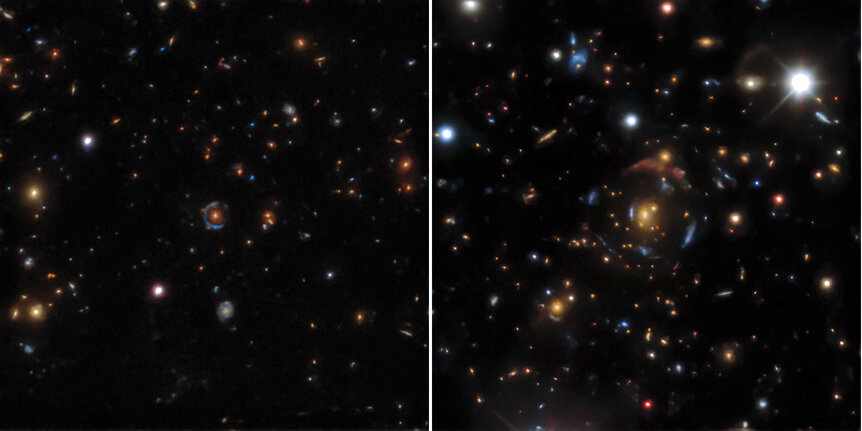Create a free profile to get unlimited access to exclusive videos, sweepstakes, and more!
A billion galaxies lurk in a 10 trillion pixel map of the sky

The sky is big. If you want to map it in detail, you have to think big, too.
Astronomers are good at that. A massive international team has just released a sky survey so huge that I'm having a hard time grasping it.
The map is the culmination of six years with 1405 nights of observations, three telescopes (and one space telescope), and one supercomputer cranking away at the data… because the survey has a total of 10 trillion pixels, and makes up a petabyte of data — a thousand terabytes, or a million gigabytes.
Oh, it also has over a billion galaxies in it. A. Billion.
Like I said: Vast.
It's the result of the DESI Legacy Imaging Surveys, maps of the sky made by the three observatories (the Dark Energy Camera Legacy Survey, the Beijing-Arizona Sky Survey, and the Mayall zband Legacy Survey, in combination with the orbiting WISE infrared observatory). They mapped the northern sky in seven colors, covering a third of the entire sky — 14,000 square degrees, or the equivalent area of 70,000 full Moons on the sky.
The ultimate goal is to better understand dark energy, the mysterious substance that's accelerating the expansion of the Universe, by looking at the distribution of galaxies throughout the Universe. They'll do that by picking tens of millions of the billion galaxies in the data and getting follow-up observations with the Dark Energy Spectroscopic Instrument (DESI), which will take spectra of those galaxies and find their distances.
Since we'll know their positions on the sky, and their distances, this will make a 3D map of the Universe larger than any ever before.
Also like I said: Think big.
The spectroscopic observations won't be done until 2024, but there's already been a tidy bounty of science from the survey observations.
For example, astronomers — including "citizen scientists", just science-loving folks who don't necessarily have formal science training — picked through the data looking for brown dwarfs, objects intermediate in mass between planets and stars, and found 525 of them within about 65 light years of the Sun in the surveys, 38 of which had never been seen before. Combined with data from the Spitzer Space Telescope, they were able to get the distances, making this the best 3D map of brown dwarfs to date.
Because the survey includes infrared light, it's sensitive to warm objects like brown dwarfs, and they think this survey should see any brown dwarf closer than 65 light years that's warmer than about 330° Celsius (620° F). They get cooler than that — in fact some brown dwarfs were found a few years ago that are actually room temperature, and there may be even cooler ones out there — so it's possible there are many more yet to be detected. Still, this is an excellent start! Brown dwarfs are faint (the first wasn't even discovered until the 1990s) and difficult to find.
This sort of thing is important because we know that stars form when clouds of gas and dust collapse, but when that happens stars of all different masses are born. Massive stars are bright, so they're easy to see, but at the low-mass end of that the stars are faint. However, far more of them are created than high mass stars, so to get a census of objects we need to better understand that faint end of the spectrum. This survey will help.
Another group of astronomers looked at far more distant objects: Individual galaxies as well as galaxy clusters, in order to find gravitational lenses. When the light from an even more distant galaxy passes near a galaxy or cluster on its way to Earth, the gravity of intervening object bends that light's path like a lens, creating distorted images of the background galaxy. The light can also be amplified quite a bit, making fainter objects appear brighter.
This phenomenon makes it possible to observe faint, distant galaxies, and see what's going on in them. It also tells us about the distribution of mass and dark matter in the galaxy and galaxy clusters, so it's a twofer.
The group applied machine learning to the DESI data, teaching an algorithm how to find gravitational lenses in the observations… and hoo my, did it. It found over 1,200 new lenses, doubling the number known up to then! I'll note they are technically candidate lenses, which need to be confirmed, but they inspected them visually so I'm confident the majority of them are real.
This is really just a taste of what's possible. Huge surveys like this are treasure troves, just huge piles of data waiting for scientists to dive in and use them for whatever research they're doing. That's the beauty of them. They're generalized, so if you're studying brown dwarfs or gravitational lenses or bright stars or dwarf galaxies or galaxy collisions, whatever, there's likely to be something useful in the survey.
You can take a look yourself, too, on the interactive viewer the team created. It's fairly intuitive; you can scroll in and out, move around, or search for your favorite object... provided the survey covered that part of the sky. There's also a chat room where (if you register) you can point out interesting objects and discuss them with others. Maybe you'll discover something!
Have fun. With well over a billion objects in the database, this should keep everyone busy for a long, long time.




























